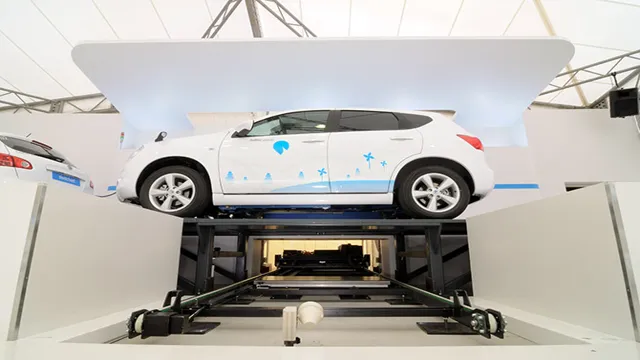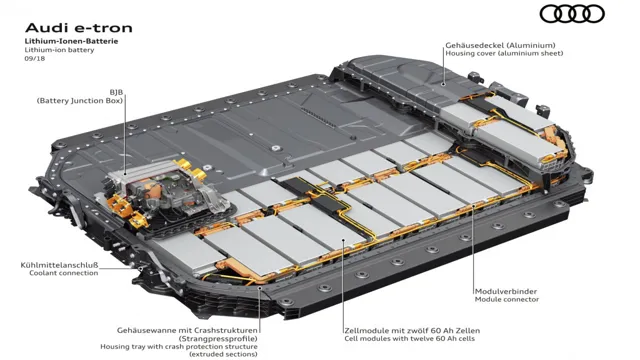Revolutionize your Commute: The Promising Future of Electric Car Battery Swapping
Electric car battery swapping is a fascinating technology that has gained momentum recently due to the growing adoption of electric vehicles. It involves quickly swapping out a depleted battery in an electric car for a fully charged one, allowing drivers to continue their journey without waiting for their car to recharge. Imagine having the ability to quickly exchange your car’s battery in the same amount of time it takes to refuel a gasoline-powered vehicle.
This innovative concept has the potential to solve many of the issues that have been holding back the widespread adoption of electric vehicles. In this blog, we’ll explore the benefits of electric car battery swapping, how it works, and what the future of this technology may hold. So let’s dive in and learn more about this exciting development in the world of electric cars.
What is battery swapping?
Battery swapping refers to the ability to replace electric vehicle batteries with fully charged ones quickly and conveniently. Instead of waiting for the battery to charge, a driver can simply pull into a swapping station where a machine automatically removes the depleted battery and installs a fully charged replacement. This process takes only a few minutes, making it a much faster option than traditional charging methods.
Electric car battery swapping can help address some of the challenges that EV owners face, such as range anxiety, by providing a quick and hassle-free way to continue their journey. While still a relatively new technology, battery swapping has already been implemented in certain regions and shows potential for wider adoption in the future.
An explanation of the process and benefits
Battery swapping is the process of replacing a depleted or low charged battery with a fully charged one. Battery swapping stations are automated systems that allow electric vehicles to swap their batteries in a matter of minutes. The main benefits of battery swapping are reducing the time it takes to recharge an electric vehicle, eliminating range anxiety, and providing a more sustainable and cost-effective solution.
Swapping out a depleted battery with a fully charged one can take as little as three minutes, which can reduce the time needed to recharge an electric vehicle significantly. With the elimination of range anxiety, electric vehicle owners can drive longer distances without worrying about running out of power. Additionally, this process can reduce the cost of EV ownership, as purchasing a new battery can be expensive.
Battery swapping stations provide a more affordable, sustainable, and convenient alternative. Battery swapping has made electric vehicles an attractive option for commuters and businesses, reducing their carbon footprint while providing a cost-effective and sustainable transportation option.

Current state of battery swapping
Electric car battery swapping is a promising technology that has been in development since the early 2000s. It allows drivers to quickly exchange their depleted battery pack for a fully charged one, eliminating the need for lengthy charging times and range anxiety. However, despite early excitement and investments from major companies like Tesla and Better Place, the technology has yet to gain widespread adoption.
The main challenges are standardization, cost, and infrastructure. Without a universal battery design and compatible swapping stations, automakers would have to invest in their own proprietary systems, which would be expensive and limit consumer choice. Additionally, building and maintaining swapping stations would require significant investment and logistical planning.
Nonetheless, some companies like Nio and Ample are pushing ahead with battery swapping as a viable alternative to charging. It remains to be seen whether the industry will reach a tipping point that leads to mass adoption of this potentially game-changing technology.
Data on the availability and usage of battery swapping stations
The current state of battery swapping stations is somewhat mixed. While there are several countries with established battery-switching infrastructures, such as China and Israel, other countries are just beginning to experiment with the technology. In the United States, Tesla has been spearheading the push towards battery swapping, but the idea has yet to catch on with other automakers.
In terms of usage, it appears that battery swapping is more popular in commercial fleets than in individual car owners. However, regardless of the current state of battery swapping, it’s clear that this technology has potential to revolutionize the electric vehicle industry. Not only does it greatly reduce charging times, but it also allows for a more efficient use of resources by allowing batteries to be reused and recycled.
As the technology becomes more mainstream, we can expect to see more battery swapping stations popping up, making it an even more convenient option for electric vehicle owners.
Battery swapping vs. traditional charging
When it comes to electric cars, one of the biggest questions is how to charge the battery efficiently. While traditional charging seems to be the most common method, there is also a rising trend in battery swapping. Battery swapping involves replacing the used battery with a fully charged one at a charging station, rather than waiting for the battery to charge at a charging point.
The advantage of swapping is that it takes less time to exchange a drained battery for a charged one than it does to charge a depleted battery from scratch. However, this method is not yet widely available, and the cost to install such a system may be more expensive than the current infrastructure for traditional charging points. Additionally, because not all electric vehicles use the same size and type of battery, swapping could be a challenge.
Nonetheless, as battery technology continues to advance, and more electric cars hit the road, the implementation of battery swapping could be a viable option to complement traditional charging.
Comparison of time, convenience, and cost
When it comes to charging an electric vehicle, there are two main options: battery swapping and traditional charging. Battery swapping involves swapping out a depleted battery with a fully charged one at a dedicated station, while traditional charging involves plugging in the vehicle and waiting for it to charge. In terms of time, battery swapping is generally faster as it takes only a few minutes to swap out the battery compared to the hours it can take for traditional charging.
However, the convenience of battery swapping is limited as it requires specific stations that may not be readily available. Traditional charging, on the other hand, can be done at home or at public charging stations, providing more flexibility in terms of convenience. In terms of cost, battery swapping can be more expensive as it requires the infrastructure for battery swapping stations whereas traditional charging can be more cost-effective as it only requires a charging unit.
Ultimately, determining which option is best for a particular situation depends on individual needs and preferences.
Future of battery swapping
Electric car battery swapping has seen a resurgence in interest recently, as automakers seek ways to reduce charging times and maximize the range of their electric vehicles. While it was tried in the past, the technology behind it was not as advanced as it is today, making battery swapping more feasible than ever. With battery swapping, EV owners can simply swap out empty batteries for fully charged ones in a matter of minutes, instead of having to wait hours for their EVs to charge.
This approach could significantly reduce the time and hassle associated with charging an electric car, making it a more viable option for drivers who might be put off by the current limitations of the charging infrastructure. As such, electric car battery swapping could be an important part of the future of EVs, and we may soon see more automakers investing in this technology to make EVs more accessible and convenient for consumers.
Technological advancements and potential for widespread adoption
The future looks bright for battery swapping technology, as its potential widespread adoption could revolutionize the way we use and think about electric vehicles. Currently, the main hurdle to the widespread use of battery swapping is the lack of standardized battery designs and protocols across EV manufacturers. However, as more and more manufacturers adopt this technology, standardization will become more feasible.
With battery swapping, EV drivers would have the option to quickly and easily swap out depleted batteries for fully charged ones, eliminating the need for lengthy charging times. This technology could also lead to a reduction in the cost of EVs, as battery leasing or rental programs would become more common. In addition, battery swapping could play a crucial role in providing sustainable energy solutions to remote and off-grid areas.
As the world continues to shift towards cleaner and more sustainable energy solutions, battery swapping technology is an exciting development that holds enormous potential for the future of transportation.
Conclusion
In summary, electric car battery swapping offers a convenient and practical solution for extending the range and ease of use of electric vehicles. It’s a bit like a power-up station for your car, but instead of mushrooms or stars, you get a fresh battery. Plus, it’s environmentally friendly and reduces the need for charging infrastructure, making it a win-win for both drivers and the planet.
So, the next time you’re on the road and running low on power, consider swapping out your battery and experience a whole new level of EV convenience!”
Summary of the benefits and drawbacks of battery swapping
Battery swapping has been touted as a possible solution to the limitations of electric vehicle (EV) recharging. The process involves replacing a depleted battery with a fully charged one at a designated station. Some of the benefits of battery swapping include faster recharging times, increased convenience for EV owners, and reduced strain on the electricity grid during peak demand.
However, there are also drawbacks, such as the high initial investment required for infrastructure, the need to standardize batteries, and concerns over battery quality and safety. Despite these challenges, some companies are investing in battery swapping technologies, with the hope of creating a more viable and sustainable future for electric mobility. Ultimately, the future of battery swapping will depend on whether it can provide enough benefits to overcome these hurdles and gain widespread adoption in the EV market.
FAQs
What is electric car battery swapping?
Electric car battery swapping is the process of replacing a depleted battery in an electric vehicle with a fully charged one.
How does an electric car battery swapping station work?
An electric car battery swapping station works by removing the depleted battery from an electric vehicle and replacing it with a fully charged one in a matter of minutes.
How long does it take to swap an electric car battery?
It typically takes between 5 to 15 minutes to swap an electric car battery depending on the make and model of the vehicle and the charging technology used.
What are the benefits of electric car battery swapping?
Electric car battery swapping offers several benefits, including shorter charging times, reduced battery degradation, increased convenience, and lower costs for electric vehicle users.





